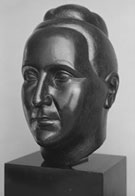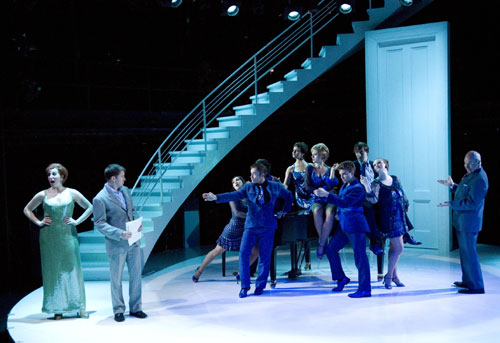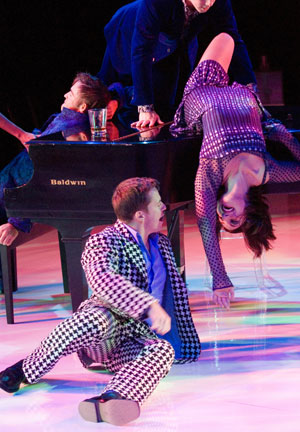|
Merrily We Roll Along
Although Gertrude Stein said to the sculptor Jacques Lipschitz as quoted in The Autobiography of Alice B. Toklas that she never mind posing, she warned him that she did not like sculpture.  She also added that Lipschitz was a wonderful gossip and that she, loving beginnings, middles and ends of stories, found Lipschitz engaging because he supplied missing parts of several stories. Could it be that Stein didn't like things set in stone, including her own bust that Lipschitz rendered in a true-to-life style? She also added that Lipschitz was a wonderful gossip and that she, loving beginnings, middles and ends of stories, found Lipschitz engaging because he supplied missing parts of several stories. Could it be that Stein didn't like things set in stone, including her own bust that Lipschitz rendered in a true-to-life style?
HOW MANY VERSIONS ARE THERE?
To this colorful Stein anecdote, the Steiny Road Poet posits the following question regarding Stephen Sondheim's musical Merrily We Roll Along with which Signature Theatre of Arlington, Virginia, bravely opened their 18th season and which the Poet saw September 9, 2007: Is a musical ever set in stone, especially this one where the story is told backwards and the audience sees more surface and less depth in its characters?
To understand the Poet's question, a short history of Merrily We Roll Along, a musical that looks at what success in the world of the musical can do to damage ideals and friendships, needs to be recited.
1981 Merrily We Roll Along, directed by Broadway master director Harold Prince, closed after 16 performances. The show previewed for 52 performances before its opening on November 16, 1981.
1981 Frank Sinatra records "Good Thing Going" from Merrily We Roll Along.
1985 La Jolla Playhouse production. This California production ran for 24 performances.
1990 Arena Stage production. This Washington, DC, production ran from January 30, 1990, to April 8, 1991.
1992 Leicester Haymarket production. This British production ran from April 10 to May 9, 1992.
1994 York Theatre Company production. This off-Broadway production in New York City ran for 54 performances.
2000 Donmar Warehouse production. This London production ran from December 1 to 11, 2000.
2002 Merrily We Roll Along produced at the Kennedy Center as part of a Sondheim Celebration. This Washington, DC, production ran for 14 performances.
To a greater or lesser degree, each of these productions saw a difference in which songs were included and in what order. The La Jolla Playhouse production dropped two songs from Act I and added three songs: "That Frank" and "Growing Up" added to Act I and "The Blob" to Act II. The Arena production building on the La Jolla production rearranged the order songs in Act I and ended with "The Hills of Tomorrow," which La Jolla had dropped. The Leicester Haymarket production also built on the La Jolla production but added six transitional compositions and an opening number for Gussie, the singer who seduced the composer-protagonist. York Theatre Company production followed the Leicester production in song selection and order. Donmar Warehouse production followed the original production re-introducing the dropped songs, but also adding "Growing Up" in Act I and "The Blob" in Act II. The Kennedy Center production followed the Leicester production but added an orchestral composition to open Act II.
WHEN THE HOUNDSTOOTH STEALS THE SHOW
Director Eric Schaeffer has followed the Kennedy Center production, where he did not direct Merrily We Roll Along, but where he was the artistic director for the overall Sondheim Celebration. What the Poet liked particularly about Signature's production was James Kronzer's simple but eloquent scenic design and Chris Lee's lighting.
 |
By Act II, the Poet appreciated what costume designer Robert Perdziola intended, however, the radical change, for example, from the extra large houndstooth checked suit that protagonist Frank Shepard wears in Act I versus the small houndstooth checked suit in Act II, underscores the problem the Poet had with Sondheim's ninth musical which opened after Sweeney Todd and before Sunday in the Park with George.  The problem is that Act I of Merrily We Roll Along seemed thin dramatically and therefore surfaces like costumes, set, and lighting needed to take up the slack. Nevertheless the Poet did not love the cleverness of the costume designer because she found the distasteful apparel distracting enough to keep asking herself why the audience was being forced to hate these characters. Although the Signature orchestra under the able direction of Jon Kalbfleisch played the music of Act I satisfactorily, the Poet was not moved by Sondheim's musical compositions until Act II, when the characters were presented at a younger age when they were less jaded and more tastefully attired. The problem is that Act I of Merrily We Roll Along seemed thin dramatically and therefore surfaces like costumes, set, and lighting needed to take up the slack. Nevertheless the Poet did not love the cleverness of the costume designer because she found the distasteful apparel distracting enough to keep asking herself why the audience was being forced to hate these characters. Although the Signature orchestra under the able direction of Jon Kalbfleisch played the music of Act I satisfactorily, the Poet was not moved by Sondheim's musical compositions until Act II, when the characters were presented at a younger age when they were less jaded and more tastefully attired.
Usually one of the saving elements of a musical with a problematic story is the dancing. Unfortunately Signature's dancers, though in synch with each other, had no particular fire in their guts to make the choreography exciting. In fact, most of the singers (they were also the dancers) had the same problem. They were technically acceptable but not able to fill up the stage with their energy except for one scene where composer Frank Shepard's collaborating lyricist and book writer Charley Kringas (played by Erik Liberman) blows up on a television talk show at his partner.
PLUMMING FOR BOTTOM NATURE
Sondheim can't take the credit for the innovation of telling this story backward. He based his musical on a 1934 play by the same name written by George S. Kaufman and Moss Hart. Maybe Sondheim should have jazzed up this story of moral decay by consulting the work of Gertrude Stein who knew how to play riffs with time and find the essential flaws in her multi-faceted characters. Consider this father depicted in Stein's novel The Making of Americans.
A boy excitedly shows his father a collection of butterflies and beetles that he has collected. The father asks isn't this cruel to kill things and make collections of them? So the boy feels upset and says he won't continue killing and collecting insects. After the boy goes to bed, a moth flies into the room and the father catches, kills and mounts it. Then he wakes up the boy exclaiming "what a good father I am to have caught and killed this one." So the boy, thoroughly confused, goes back to his insect collecting.
The Poet brings up this story by Stein because Frank Shepard has a son whom he says he loves very much but the audience never learns what his love for this boy means. Did they play music or baseball together? Did they catch butterflies and kill them? Merrily We Roll Along is just too much veneer. Sondheim needed to get below the surface to what Gertrude Stein called Bottom Nature.
Photos - Scott Suchman
|
